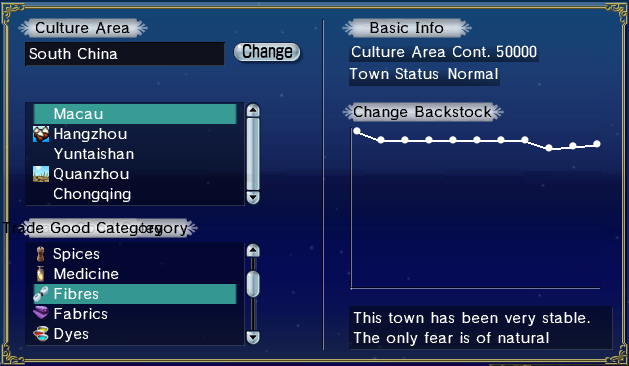The way you make money from nanban trade involves bringing proper trade goods to East Asia, exchanging them for maximum amounts of valuable goods which you then sell for maximum possible amount in other cultural area (European areas in general pay highest prices).
Nanban trade can be performed with 4 countries and total of 13 cities:
How much and which goods you will receive upon exchange depends on several factors all of which has to be taken into account while trading:
1. Backstock levels
2. Perceived value of trade good delivered
3. Backstock changes
4. City situation
5. Contribution level
Backstock
Understanding backstock levels is a cornerstone of the successful exchange. Nanban merchants will give you high amount of nanban goods they have lots of (high backstock) only you deliver what they don't currently have on stock (low backstock). In other words provide them with what they dont have and receive lots of goods they have surplus of.
All backstock information can be obtained from Nanban Trade Merchants in all European major cities and several other selected cities around the world. Information Nanban Trade Merchants provide refer to trade goods types eg. livestock, foodstuffs, wares etc. Also Nanban Trade Merchants in each East Asian city provide backstock information.
Pictures below present typical high backstock and low backstock situation. Please note that separate information is provided for each city since backstock situation will vary between cities.
| High backstock |
 |
Don't bring these goods
Expect to get lot of these goods in exchange |
| Low backstock |
 |
Bring those goods
Don't expect to get lot of these goods in exchange |
The lower the backstock of goods type we bring the more nanban goods we can expect in exchange. Same goes for high backstock of goods we want to receive. The higher it is the more we will be offered. Winning situation is if we bring goods which backstock is almost at the bottom and you take back goods which backstock is near the ceiling.
Value of goods
It is not enough to bring trade goods they dont have in East Asia in order to get lot of nanban goods. Trade goods you bring must be of the right type and they also have to be highly valued. There is no other way to tell which particular trade goods are highly valued than testing it in game. You can also refer to our Goods to bring guide.
Please note that you will not get lot of nanban goods in exchange if you bring goods they don't value in East Asia, even if their backstock is low.
Backstock changes
Backstock levels are not fixed. They change over time. There are two factors that influence changes in backstock levels: trend and players behaviour. Backstocks trend can be observed on the backstock information. Backstock graph is updated 5 times per hour. Picture below present typical example of trend:

Please note that trend patterns are different for each trade good type, for each city and for each city status. Detailed information about trend patterns can be found in our Backstock trends guide
Players behaviour may have significant influence on backstock levels further strenghtening the trend or introducing temporary change in backstock that is against current trend. Players influence backstock levels when they deliver certain good type and take other goods in exchange. When players deliver goods backstock levels go up, and when they receive goods backstock falls down. Depending on the amounts delivered and received these change may be quite noticeable. Picture below shows examples of player-induced changes to backstock levels:

Since backstock level is dynamic you should take its changes into consideration when planning your trade. Buying trade goods that East Asia values may take quite some time, so you need to try to forecast what backstock levels are going to be when you arrive in East Asia instead of planning your trade based on backstock levels you observed before you started buying goods to bring to East Asia.
City situation
There are ten city statuses which influence backstock trends and amount of EA goods you receive in exchange. These statuses are the following:
1. Normal
2. War
3. Plague
4. Drought
5. Flood Damage
6. Cold Damage
7. Recession
8. Boom
9. Build Ship Special Order
10. Festival
Baseline status is Normal. When city has this status trend pattern as well as amounts of goods received are at they default settings for this city. When status changes both trend pattern as well as amounts ae influenced in way typical for the status. For example: if city is in Recession status backstock for most of goods will skyrocket.
The opposite situation is Boom status when backstock for most of goods will plummet. When you observe city status you may get pretty good idea what is going to happen with backstocks within coming periods of time. More detailed information regarding city statuses can be found in our
City status guide.
Detailed information about how city status influence backstock trend and amount of goods received can be found in our Backstock trends guide.
Contribution level
At the beginning you can trade with only one city from each country (first city in the table marked bold). Other cities are available once you reach certain number of contribution points. Also some EA goods are available after you reach expected contribution level.
Contribution is obtained if you deliver trade goods that East Asia needs and values. The more you bring of valuable goods when backstock is low the more contribution points you are going to get from your trade. Please note however that if you deliver goods of which backstock is high contribution points are going to be deducted from you. See our
Nanban Contribution guide to check what are contribution requirements for each city and nanban goods.




